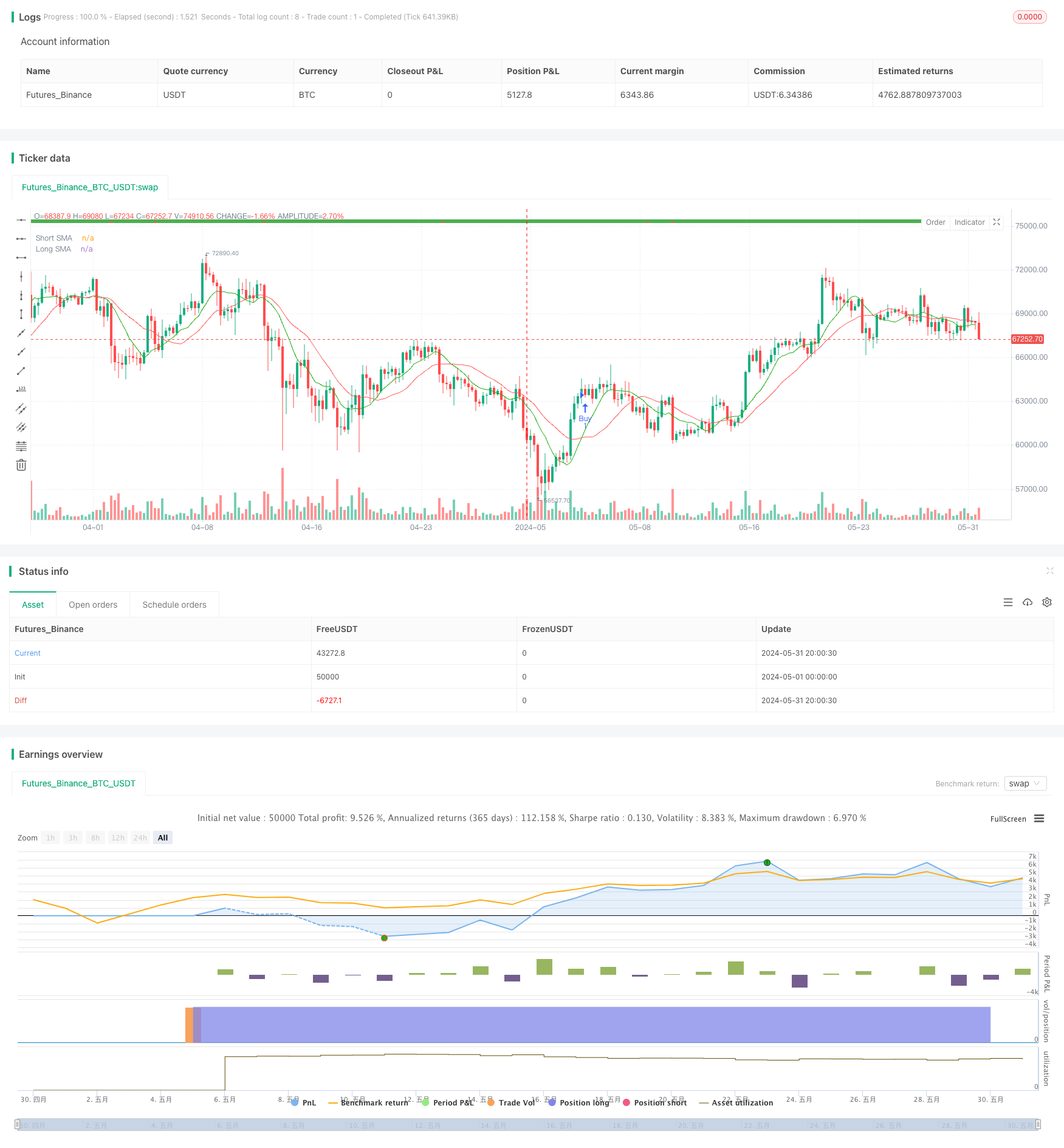
概述
该策略基于不同时间尺度的简单移动平均线(SMA)来捕捉市场趋势。通过比较短期和长期SMA的相对位置,生成买入和卖出信号。同时,该策略采用趋势确认条件来过滤伪信号,提高交易准确性。此外,该策略还设置了止盈和止损功能,实现风险管理。
策略原理
- 计算短期和长期SMA,用于判断市场趋势方向。
- 当短期SMA上穿长期SMA时,生成买入信号;当短期SMA下穿长期SMA时,生成卖出信号。
- 利用趋势确认条件过滤伪信号,只有当主要趋势为多头时才执行买入,只有当主要趋势为空头时才执行卖出。
- 设置止盈和止损功能,控制交易风险。当价格达到预设的止盈或止损水平时,平仓离场。
- 根据趋势确认条件动态调整持仓。当主要趋势发生变化时,及时平仓,防止趋势反转带来的损失。
策略优势
- 趋势跟踪:该策略基于不同时间尺度的SMA,能够有效捕捉市场主要趋势,适应不同市场状态。
- 趋势确认:通过引入趋势确认条件,过滤伪信号,提高交易信号的可靠性,减少无效交易。
- 风险管理:内置止盈和止损功能,帮助控制交易风险,保护投资者资金安全。
- 动态调整:根据趋势确认条件动态调整持仓,及时应对市场变化,减少趋势反转带来的损失。
策略风险
- 参数优化风险:该策略的表现依赖于SMA周期、止盈止损水平等参数的选择。不恰当的参数设置可能导致策略效果不佳。
- 震荡市风险:在震荡市场环境下,频繁的交易信号可能导致过度交易,增加交易成本和风险。
- 突发事件风险:面对突发重大事件,市场可能出现剧烈波动,该策略可能无法及时应对,导致较大损失。
策略优化方向
- 引入更多技术指标:结合其他技术指标,如MACD、RSI等,提高趋势判断的准确性和稳健性。
- 优化参数选择:通过历史数据回测和参数优化,寻找最佳的SMA周期、止盈止损水平等参数组合,提升策略表现。
- 改进风险管理:引入更高级的风险管理技术,如动态止损、仓位管理等,进一步控制风险敞口。
- 适应不同市场状态:根据市场波动性和趋势强度,动态调整策略参数,使策略能够适应不同的市场状态。
总结
该多时间尺度SMA趋势跟踪与动态止损策略利用不同时间尺度的SMA捕捉市场趋势,通过趋势确认条件过滤伪信号,同时设置止盈止损和动态持仓调整功能,实现了趋势跟踪和风险管理的目标。尽管该策略具有一定优势,但仍面临参数优化、震荡市和突发事件等风险。未来可通过引入更多技术指标、优化参数选择、改进风险管理和适应不同市场状态等方面进行优化,以提升策略的稳健性和盈利能力。
策略源码
/*backtest
start: 2024-05-01 00:00:00
end: 2024-05-31 23:59:59
period: 6h
basePeriod: 15m
exchanges: [{"eid":"Futures_Binance","currency":"BTC_USDT"}]
*/
//@version=5
strategy("market slayer v3", overlay=true)
// Input parameters
showConfirmationTrend = input(title='Show Trend', defval=true)
confirmationTrendTimeframe = input.timeframe(title='Main Trend', defval='240')
confirmationTrendValue = input(title='Main Trend Value', defval=2)
showConfirmationBars = input(title='Show Confirmation Bars', defval=true)
topCbarValue = input(title='Top Confirmation Value', defval=60)
short_length = input.int(10, minval=1, title="Short SMA Length")
long_length = input.int(20, minval=1, title="Long SMA Length")
takeProfitEnabled = input(title="Take Profit Enabled", defval=false)
takeProfitValue = input.float(title="Take Profit (points)", defval=20, minval=1)
stopLossEnabled = input(title="Stop Loss Enabled", defval=false)
stopLossValue = input.float(title="Stop Loss (points)", defval=50, minval=1)
// Calculate SMAs
short_sma = ta.sma(close, short_length)
long_sma = ta.sma(close, long_length)
// Generate buy and sell signals based on SMAs
buy_signal = ta.crossover(short_sma, long_sma)
sell_signal = ta.crossunder(short_sma, long_sma)
// Plot SMAs
plot(short_sma, color=color.rgb(24, 170, 11), title="Short SMA")
plot(long_sma, color=color.red, title="Long SMA")
// Confirmation Bars
f_confirmationBarBullish(cbValue) =>
cBarClose = close
slowConfirmationBarSmaHigh = ta.sma(high, cbValue)
slowConfirmationBarSmaLow = ta.sma(low, cbValue)
slowConfirmationBarHlv = int(na)
slowConfirmationBarHlv := cBarClose > slowConfirmationBarSmaHigh ? 1 : cBarClose < slowConfirmationBarSmaLow ? -1 : slowConfirmationBarHlv[1]
slowConfirmationBarSslDown = slowConfirmationBarHlv < 0 ? slowConfirmationBarSmaHigh : slowConfirmationBarSmaLow
slowConfirmationBarSslUp = slowConfirmationBarHlv < 0 ? slowConfirmationBarSmaLow : slowConfirmationBarSmaHigh
slowConfirmationBarSslUp > slowConfirmationBarSslDown
fastConfirmationBarBullish = f_confirmationBarBullish(topCbarValue)
fastConfirmationBarBearish = not fastConfirmationBarBullish
fastConfirmationBarClr = fastConfirmationBarBullish ? color.green : color.red
fastConfirmationChangeBullish = fastConfirmationBarBullish and fastConfirmationBarBearish[1]
fastConfirmationChangeBearish = fastConfirmationBarBearish and fastConfirmationBarBullish[1]
confirmationTrendBullish = request.security(syminfo.tickerid, confirmationTrendTimeframe, f_confirmationBarBullish(confirmationTrendValue), lookahead=barmerge.lookahead_on)
confirmationTrendBearish = not confirmationTrendBullish
confirmationTrendClr = confirmationTrendBullish ? color.green : color.red
// Plot trend labels
plotshape(showConfirmationTrend, style=shape.square, location=location.top, color=confirmationTrendClr, title='Trend Confirmation Bars')
plotshape(showConfirmationBars and (fastConfirmationChangeBullish or fastConfirmationChangeBearish), style=shape.triangleup, location=location.top, color=fastConfirmationChangeBullish ? color.green : color.red, title='Fast Confirmation Bars')
plotshape(showConfirmationBars and buy_signal and confirmationTrendBullish, style=shape.triangleup, location=location.top, color=color.green, title='Buy Signal')
plotshape(showConfirmationBars and sell_signal and confirmationTrendBearish, style=shape.triangledown, location=location.top, color=color.red, title='Sell Signal')
// Generate trade signals
buy_condition = buy_signal and confirmationTrendBullish and not (strategy.opentrades > 0)
sell_condition = sell_signal and confirmationTrendBearish and not (strategy.opentrades > 0)
strategy.entry("Buy", strategy.long, when=buy_condition, comment ="BUY CALLS")
strategy.entry("Sell", strategy.short, when=sell_condition, comment ="BUY PUTS")
// Take Profit
if (takeProfitEnabled)
strategy.exit("Take Profit Buy", from_entry="Buy", profit=takeProfitValue)
strategy.exit("Take Profit Sell", from_entry="Sell", profit=takeProfitValue)
// Stop Loss
if (stopLossEnabled)
strategy.exit("Stop Loss Buy", from_entry="Buy", loss=stopLossValue)
strategy.exit("Stop Loss Sell", from_entry="Sell", loss=stopLossValue)
// Close trades based on trend confirmation bars
if strategy.opentrades > 0
if strategy.position_size > 0
if not confirmationTrendBullish
strategy.close("Buy", comment ="CLOSE CALLS")
else
if not confirmationTrendBearish
strategy.close("Sell", comment ="CLOSE PUTS")
// Define alert conditions as booleans
buy_open_alert = buy_condition
sell_open_alert = sell_condition
buy_closed_alert = strategy.opentrades < 0
sell_closed_alert = strategy.opentrades > 0
// Alerts
alertcondition(buy_open_alert, title='Buy calls', message='Buy calls Opened')
alertcondition(sell_open_alert, title='buy puts', message='buy Puts Opened')
alertcondition(buy_closed_alert, title='exit calls', message='exit calls ')
alertcondition(sell_closed_alert, title='exit puts', message='exit puts Closed')
相关推荐